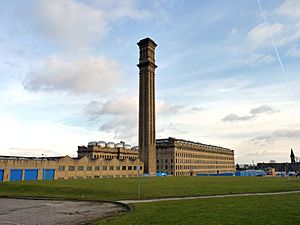- Lister Mills
-
Lister's Mill (otherwise known as Manningham Mills) was the largest silk factory in the world. It is located in the Manningham district of Bradford, West Yorkshire, UK and was built by Samuel Cunliffe Lister to replace the original Manningham Mills that were destroyed by fire in 1871.[1] The mill is a Grade II* listed building, built in the Italianate style of Victorian architecture.
At its height, Lister's employed 11,000 men, women and children - manufacturing high-quality textiles such as velvet and silk. It supplied 1,000 yards (910 m) of velvet for King George V's coronation and in 1976 new velvet curtains for the President Ford White House. The 1890-91 strike at the mill was important in the establishment of the Independent Labour Party which later helped found the modern-day Labour Party. On completion in 1873, Lister's Mill was the largest textile mill in North England. Floor space in the mill amounts to 27 acres (109,000 m²), and its imposing shape remains a dominant feature of the Bradford skyline. The chimney of the mill is 255 feet (78 m) high, and can be seen from most areas of Bradford.
Powering all the machinery switched over to electricity in 1934. Before that huge steam boilers drove the mill. Every week the boilers consumed 1,000 tons of coal brought in on company rail wagons from the company collieries near Pontefract. Water was also vital in the process and the company had its own supply network including a large covered reservoir on-site (now in 2006 that area is a piazza and underground car park).
During World War II Lister's produced 1,330 miles (2,140 km) of real parachute silk, 284 miles (457 km) of flame-proof wool, 50 miles (80 km) of khaki battledress and 4,430 miles (7,130 km) of parachute cord.
Contents
Decline
The Lister's business decreased considerably during the 1980s. Stiff foreign competition and changing textile trends such as increased use of artificial fibres were the reasons. In 1992 the mills were closed.[1] Being a prominent structure the mills attracted a great deal of attention and several regeneration proposals came and went. The sheer size of the buildings being a major difficulty. However local residents, former workers and notably Reverend George Moffat never lost hope that the mills would rise again. They campaigned hard to save the mills.
Rebirth
In 2000 property developers Urban Splash bought the mills. They planned to to renovate the existing larger buildings and build new ones. Apartments, workplaces, shops and public spaces were planned to be part of Listers. A deal was finally struck whereby remedial work on the structures and removal of industrial waste would be part-funded by Yorkshire Forward, Bradford Council and English Heritage. In September 2004 Freda Watts, a former silk weaver at Listers, cut a ribbon across the entrance to the mills - construction work had started.
The next landmark for the 100 million GBP project was the sales launch of the first phase. In late 2004 over 2,000 people queued (some overnight) to buy one of the 131 apartments being created in the south mill, now renamed Silk Warehouse. It was a sell out and a great boost for the project and the wider regeneration of Bradford [2][3]
New residents started moving in during 2006. The next phase, regenerating the second large building is to be called Velvet Mill. It is planned to replace the existing roof on this building with a glass and steel structure housing two storey apartments.[4] David Morley practice are the architects. The new homes went on sale in early 2007. The plan is to create a new piazza with the huge mill chimney at its centre.
References
- ^ a b Pearman, Hugh (14 November 2004). "The ultimate conversion". The Sunday Times. http://property.timesonline.co.uk/tol/life_and_style/property/new_homes/article391578.ece. Retrieved 9 June 2011.
- ^ "myManningham". http://www.mymanningham.org.uk/. Retrieved 2009-12-02.
- ^ "Welcome to Bradford Centre Regeneration". http://www.bradfordurc.co.uk/. Retrieved 2009-12-02.
- ^ "This is Bradford". http://www.thisisbradford.co.uk/news/tibnews/display.var.885717.0.getting_ready_to_raise_roof_at_mill.php. Retrieved 2009-12-02.
External links
Coordinates: 53°48′33″N 1°46′45″W / 53.8091°N 1.7791°W
Categories:- Grade II* listed buildings in West Yorkshire
- Buildings and structures in Bradford
Wikimedia Foundation. 2010.

